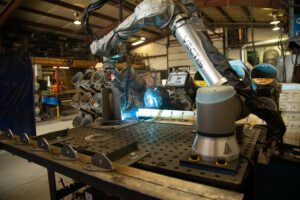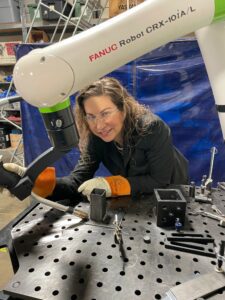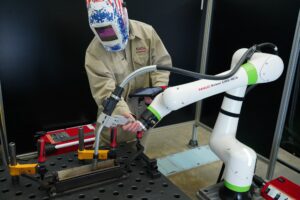Use Automation to Attract, Retain and Develop Your Welding Workforce
When a company introduces automation, they have the opportunity to create a more cohesive workforce because the investments foster a more attractive work environment and build team spirit.
Posted: January 17, 2023

The struggle to acquire, grow and retain talent remains the welding industry’s leading challenge. As the American Welding Society (AWS) reports on its WeldingWorkfaceData.com website, the industry needs to fill 84,000 welding jobs annually between now and 2025.
While that number seems daunting, it is achievable, and automation will be essential. As visitors to a highly successful FABTECH 2022 will report, there are more robot and cobot solutions — and associated careers — now available than anyone could have predicted just five years ago. The welding and welding automation pavilions at FABTECH had perhaps the most consistent and busiest floor traffic because of the massive amount of new automation technology exhibited.

For a deeper dive into how companies could add automation to their business, AWS coordinated a panel discussion at the FABTECH Theater with four automation industry experts:
- Karen Gilgenbach, CWI, CWS, CRAW-T, zone vice president for MATHESON, a leading gas and equipment company. She is also the incoming chair for the AWS D16 Committee on Robotic and Automatic Welding. This committee authored the AWS D16.4 Specification for the Qualification of Robotic Welding Personnel.
- Doug Rhoda, chairperson and founder of Vectis Automation, which offers turnkey welding and plasma cutting systems based on a cobot from Universal Robots.
- Lou Finazzo, vice president of the Automated Systems Group, FANUC America, the industry’s most familiar brand of robots, cobots and automation technology.
- Robby Komljenovic, chairperson and CEO of Acieta, a FANUC Authorized System Integrator that has installed more than 5,500 robotic systems.
To further explore the automation workforce development topic after the show, AWS followed up with these companies and two more of their experts, Vectis founding partner Josh Pawley, and Acieta Regional Automation Manager Nick Cowell. Here are key take-aways from the conversation.
Automation Attracts Young Workers

“Everyone jokes that if you need help with your iPhone, ask a teenager because they grew up with the technology,” said Gilgenbach, the first woman to complete the AWS Certified Robotic Arc Welding – Technician (CRAW-T) in 2011. “For young people, automation has that same type of tech appeal compared to a manual or semi-automatic operation. I find it satisfying when you get a part programmed and create a perfect weld. With a really good robotic weld, there’s just nothing like it because the robot keeps a constant travel speed and torch angle.”
Cowell used a similar generational-appeal strategy at a recent high school career exploration event near Acieta’s Council Bluffs, Iowa, facility.
“I knew the kids weren’t going to be able to relate to an old guy like me, so I brought one of our young robot engineers with me,” he says. “I talked to them about things like culture, pay and benefits. The robotic engineer brought a teach pendant with him and basically said: ‘Here’s my video game. I get to play video games every day.’ He was a hit and had a big crowd around him.”
“Speaking of video, social media is changing the impression of manufacturing,” added Komljenovic. “YouTube influencers put out videos that show how cool and automated manufacturing facilities are in general. They look different compared to the facilities their parents went into after graduation.”
When it comes to workforce development, parents are the ultimate influencer group said Finazzo.
“Parents matter the most,” he said. “When we give tours or hold events, we always start off by asking about their current perception of manufacturing. That leads us into sweet spots where we can show how welding automation creates a cleaner environment, allows people to work with their brain versus their back and increases their influence on the success of a company.”
To help young people prepare for a welding career, AWS offers special rates for students and those early in their career, which encompasses welding professionals less than 35 years old or with less than five years of industry experience (learn more at aws.org/takethetorch). The AWS Foundation also offers more than $2 million in scholarships.
Automation Builds Diversity
Gilgenbach believed that automation will inherently increase the diversity of potential welding candidates.
“There might be people that never saw themselves as a welder, but when they see a robot welding, they might see themselves as a robot programmer or a technician,” she said. “Automation creates wider breadth of career paths for a diverse pool of candidates to enjoy in the welding field.”
“Cobots make manufacturing cool,” said Vectis’ Pawley. “If you ask someone to weld up 300 brackets a week, that doesn’t sound interesting. If you ask them to use a cobot to weld 300 brackets in one-third the time of a manual welder, that’s a challenge the new generation can buy into.”
Automation also helps attract people in the middle or later stages of their career who want to alleviate the physical tolls of welding or flex their mind more than their muscles. Automation also appeals to people of smaller stature who might have concerns about the physical demands of the job. Welding is also a great second-chance career for those with a criminal record.
“Part of the diversity appeal is that ergonomics of automation makes welding a less dirty and dangerous job,” Cowell said. “It can minimize hazards related to sharp edges, heavy plates, crawling on large weldments and proximity to sparks and fumes.”
“We’ve seen a lot of folks that enjoy the science of welding or are interested in manufacturing but don’t have the dexterity,” Pawley said. “Automation gives them a different way to be engaged with a welding system.” Alternatively, running a cobot enables people to make significant contributions while they hone their manual welding skills and obtain certifications, which is a proven path to greater earning power.
Welders Make Better Cobot and Robot Operators
Henry Ford quipped that if he asked customers what they wanted, they would have said, “A faster horse.” The topic came up during the automation panel because when the U.S. shifted from the horse and buggy to automobiles, the skills needed to make a buggy or shoe a horse did not transfer to automobile manufacturing.
“What I think is so unique about robotic technology is that manual or semi-automatic welding skills transfer to welding automation, especially with the ease of programming on some robots or cobots,” Gilgenbach said. As examples, she noted that while anyone can learn to program a straight line between two points, an experienced welder will be best equipped to understand and program the correct torch angle and contact-tip-to-work distance.
Pawley noted that, “By making better welds with automation, you need less grinding afterward. Grinding is a non-value-added activity. If you want to talk about workforce development, you know what welders don’t want to do all day? Grind!”
Automation Creates Job Opportunities
Vectis’ Doug Rhoda has been in the automation industry for more than 35 years. He said that when he started in the mid-1980s, there were a lot of adversarial issues between welding operators and management.
“I think we have progressed to a recognition that if we don’t automate, we can’t compete,” he said. “We understand that automation is a tool to help workers make products better, faster and safer, and that we need to deploy these tools in order to keep work in this country.”
“Our philosophy is that automation, and cobots in particular, are a labor subsidy,” Finazzo said. “Automation allows your workforce to deliver a strong output without having to give up something in return. The bottom line is that if you don’t have the right amount of people in your shop, or the right production capacity or turnaround time, you’re going to lose opportunities.”
One of the opportunities is a new title: automation champion. Every panelist agreed that any company implementing automation needs a champion — and that champions can come from where you least expect them.
“A story that I remember from our team was a bridge manufacturer in Connecticut,” Rhoda said. “There was an entry level, 19-year-old grinder that was really intrigued with the cobot coming in. He really wanted to learn it and be that champion. He was able to upskill, to increase his skill level to the point where he’s producing now the D1.5 certified bridge structural welds with the cobot.”
Automation Creates a New Culture
When a company introduces automation, they have the opportunity to create a more cohesive workforce.
“Going through a training program and then programming parts on your own shop floor builds confidence,” Cowell said. “After success with four or five parts, an automation team will see other opportunities within their shop and just run with them. My point is that you’re not automating the welding of a widget — you’re upskilling your workforce. You’re going to want to train two, three or four people deep on any one operation. Your automation champions will then teach other people. With those types of successes, you’re going to create new culture.”
Cowell noted that automation training can increase retention. People see employers are investing in them, creating a more attractive work environment and building a team spirit. A good work environment makes people less likely to leave for a minor pay increase.
Automation Frees Skilled Labor
Contrary to popular belief, companies should not automate their most complex problem.
“Please don’t use your most complex part to start your automation journey,” Komljenovic said. “The right approach is to get a quick win. You create trust in automation when you have your champion win. To make that happen, you need to define success and failure and define important metrics.”
“Even with the latest vision systems and seam tracking technology, people are still smarter than robots,” Gilgenbach said. “Humans can compensate for poor fit-up or irregular gaps. You may not want to pick a part that causes you headaches in production because you think a robot can overcome variations from your upstream processes. Instead, look for parts where an operator is doing simple, repetitive work. If you see the welder standing in one place, putting components into a fixture and making the same welds over and over again (or even sitting), that can be an area worth exploring.”
“Offload the boring stuff,” Pawley stated. “Humans want to focus on higher skill work that keeps them awake. Automation is a win for the individual and a win for the business because a cobot can do the boring stuff at a 2x-to-4x higher productivity rate.”
The Tipping Point
Because advancements in technology have made automation more accessible to small and medium businesses, and because automation is broadening the appeal of welding at a time of great need, Finazzo believed the industry is at an inflection point. It is poised to achieve an unprecedented level of adoption.
“I strongly encourage all OEMs and equipment manufacturers to get involved in their community and tech schools to develop curriculum around their manufacturing processes,” he said. “It’s a self-fulfilling prophecy where we can create the next generation of welders with more involvement. In the past, it took a year or more for an operator to really have an impact. With automation skills, we’re seeing students graduate and impact a company within 30 days.”
To learn more about the AWS Certification Program for Robotic Arc Welding, AWS courses and other professional certifications, visit www.aws.org/certification.
Subscribe to learn the latest in manufacturing.



















